Uncategorized
GSSI, the world’s leading manufacturer of ground penetrating radar (GPR) equipment, 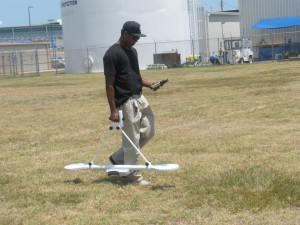 announces the availability of its Profiler™ EMP-400 multi-frequency electromagnetic (EM) conductivity meter for use in geological investigation, site assessment, ground water investigation, and other environmental assessment applications. With a user-friendly design and unmatched signal stability, this powerful electromagnetic induction tool allows for reliable and accurate examination of soil conditions and subsurface targets on both small and large scale sites.
announces the availability of its Profiler™ EMP-400 multi-frequency electromagnetic (EM) conductivity meter for use in geological investigation, site assessment, ground water investigation, and other environmental assessment applications. With a user-friendly design and unmatched signal stability, this powerful electromagnetic induction tool allows for reliable and accurate examination of soil conditions and subsurface targets on both small and large scale sites.
“The GSSI Profiler EMP-400 is a valuable tool that provides our clients with more efficient and comprehensive geophysical surveys. We have been impressed with its simplicity to deploy in the field and the data it outputs to create an easy to understand sub-surface image of our geophysical survey areas,” said Fletcher S. Thompson of E.F. Thompson Geotechnologies, Inc.
Featuring a lightweight, environmentally sealed EM instrument and handheld interface with integrated GPS, GSSI’s Profiler offers users premium mobility and ease of transport. Advanced software features offer the user several options to view the data in real time, thereby enhancing survey efficiency. For instance, the “freeway” collection mode allows the user to collect data by using GPS coordinates as reference points rather than setting up a physical grid on the ground. The Profiler then provides real-time data output via a color-coded map, which enables the user to quickly and easily identify areas of interest on site.Additionally, the Profiler stores files in a Microsoft Excel format in internal memory for later access.
The Profiler EMP-400 is commonly used in concert with GSSI’s UtilityScanÒGPR system, an industry leader in environmental assessment. The Profiler EMP-400 provides a fast and effective survey method for large-scale environmental assessments, such as UST and drum locating, plume mapping and landfill delineation. Users can employ the Profiler as a quick reconnaissance level survey tool to narrow down areas of interest on large survey sites, and then use the UtilityScan GPR system to concentrate on anomalies. Additionally, GSSI offers unlimited, free training for 2 years, free lifetime support, and a 2 year warranty with the Profiler product.
About GSSI
Geophysical Survey Systems, Inc. is the world leader in the development, manufacture, and sale of ground penetrating radar (GPR) equipment, primarily for the concrete inspection, utility mapping and locating, road and bridge deck evaluation, geophysics, and archaeology markets. Our equipment is used all over the world to explore the subsurface of the earth and to inspect infrastructure systems non-destructively. GSSI created the first commercial GPR system nearly 45 years ago and continues to provide the widest range and highest quality GPR equipment available today.
Uncategorized
(New York, N.Y. – May 2, 2016) The U.S. Environmental Protection Agency has allotted $8,249,000 to the United States Virgin Islands to help finance improvements to water projects that are essential to protecting public health and the environment. The funds will primarily be used to upgrade wastewater systems and drinking water systems throughout the territory.
“Clean drinking water and proper wastewater treatment are fundamental to protecting people’s health, but aging water infrastructure needs to be upgraded and repaired,” said EPA Regional Administrator Judith A. Enck. “This funding will help the U.S. Virgin Islands upgrade their drinking water and sewage treatment systems, both of which are imperative for healthy communities.”
The Clean Water State Revolving Fund program, administered by the Virgin Islands Department of Public Works, was allotted $4,129,000. The program provides grants for water quality protection projects to make improvements to wastewater treatment systems, control pollution from rain water runoff, and protect sensitive water bodies and estuaries.
The Drinking Water State Revolving Fund program, administered by the Virgin Islands Department of Planning and Natural Resources, was allotted $4,120,000. The program provides grants to finance improvements to drinking water systems, with a particular focus on providing funds to small and disadvantaged communities.
Since 1989, the EPA has awarded $78,424,380 million to the U.S. Virgin Islands through these programs, which are funded annually.
For more information on the Clean Water State Revolving Fund program, visit https://epa.gov/cwsrf
For information on the Drinking Water State Revolving Fund program visit https://epa.gov/drinkingwatersrf
Follow EPA Region 2 on Twitter at http://twitter.com/eparegion2 and Facebook at http://facebook.com/eparegion2
Uncategorized
LAKE MILLS, Wisc.– The North American Society for Trenchless Technology (NASTT) has
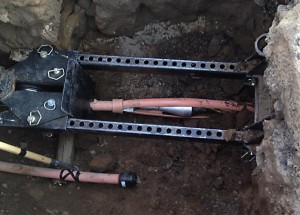 chosen HammerHead Trenchless Equipment’s Same Path™ gas line slitting technology for recognition as an industry-leading innovation in 2016. Each year NASTT judges choose just two products contributing to the advancement of trenchless solutions to receive its Abbott Innovative Product Award. Judging and presentation take place during the annual NASTT No-Dig Show, held this year in Dallas, Texas, March 20 through 24.
chosen HammerHead Trenchless Equipment’s Same Path™ gas line slitting technology for recognition as an industry-leading innovation in 2016. Each year NASTT judges choose just two products contributing to the advancement of trenchless solutions to receive its Abbott Innovative Product Award. Judging and presentation take place during the annual NASTT No-Dig Show, held this year in Dallas, Texas, March 20 through 24.
HammerHead Same Path Gas Line Slitting Technology is a tooling system for replacing natural gas distribution pipe that cannot be replaced by traditional bursting methods. The tooling is designed for use with the HammerHead line of cable winches.
HammerHead Trenchless Equipment, a Charles Machine Works company, originally designed
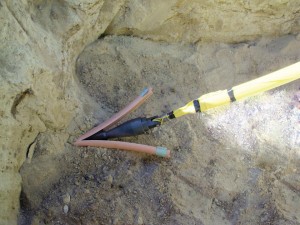 the tooling at the request of Ditch Witch in California. Mike Anderson, Ditch Witch Bay Area, Central & Southern California president, and two in-house HammerHead equipment specialists, Kevin Campbell and Cameron Zoucha, had identified a need for better gas line slitting technology. HammerHead engineering worked with them to develop the tooling and methodology successfully used in the field by the Ditch Witch in California group since its introduction.
the tooling at the request of Ditch Witch in California. Mike Anderson, Ditch Witch Bay Area, Central & Southern California president, and two in-house HammerHead equipment specialists, Kevin Campbell and Cameron Zoucha, had identified a need for better gas line slitting technology. HammerHead engineering worked with them to develop the tooling and methodology successfully used in the field by the Ditch Witch in California group since its introduction.
Anderson said, “We needed to help a customer frustrated by existing tooling that tended to either bunch up the pipe or high-center and get stuck. We turned to HammerHead engineering, which has a history of developing solutions for unique problems.”
HammerHead Same Path tooling is designed to overcome those issues while simultaneously splitting old pipe and installing new pipe.
“Usually you expect tool design to come as a result of trial and error,” Anderson said. “In this case it was trial and success, an effective product within weeks of our initial request that surpasses any gas line slitting system I’ve seen to date.”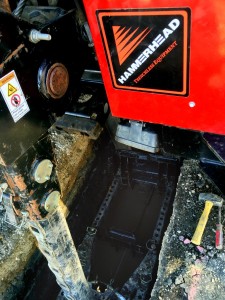
HammerHead Same Path Gas Line Slitting Technology is designed for replacing half-inch to 4-inch natural gas distribution pipe and may also be used to decommission inactive gas lines that will be left in the ground. The unique slitting process follows the existing pipe path, reducing the likelihood of contact with other utilities.
Same Path tool string components include expanders, connectors, and slitting tools with replaceable hardened-steel blades, breakaways and beacon housings. Used in conjunction with the HammerHead line of cable winches and Subsite® electronics, the tooling’s string design permits virtually trouble-free pullback in PVC, HDPE, MDPE and Aldyl-A pipe and limits torque on new MDPE or HDPE replacement pipe to within approved manufacturer’s standards.
Same Path gas line slitting technology is available from HammerHead Trenchless Equipment or from authorized dealers worldwide. Authorized dealers can be found online at www.hammerheadtrenchless.com or by calling 800.331.6653. (International: + [1] 920.648.4848).
Photo 1:HammerHead® Same Path™ gas line slitting technology is a tooling system specially designed to replace natural gas distribution pipe lines that are not good candidates for traditional bursting methods.
Photo 2:Same Path™ gas line slitting technology is designed for use with the HammerHead® line of HydroGuide® cable winches. A HydroGuide winch’s self-deploying downrigger simplifies setup time and places hydraulic pulling power directly in line with the slitting operation.
Photo 3:The Same Path™slitting head has been retrieved all the way back to the extraction cage, never having left the path of the in situ pipe. The pipe line is now unequivocally decommissioned or, if new product pipe has been attached to the slitting head, it is replaced in the same smooth operation.
Uncategorized
ST. LOUIS, MO, April 19, 2016 — Aegion Corporation (“Aegion” or the “Company”) (Nasdaq
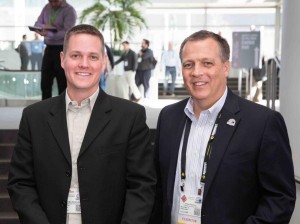 Global Select Market: AEGN) today announced that Frank Firsching has been named the President of its Infrastructure Solutions platform and will have direct responsibility for the overall growth and profitability of the North America and European Insituform business, Underground Solutions, Inc. and Fyfe/Fibrwrap North and South America. In 2015, this business reported over $550 million in revenues.
Global Select Market: AEGN) today announced that Frank Firsching has been named the President of its Infrastructure Solutions platform and will have direct responsibility for the overall growth and profitability of the North America and European Insituform business, Underground Solutions, Inc. and Fyfe/Fibrwrap North and South America. In 2015, this business reported over $550 million in revenues.
Charles R. Gordon, Aegion President and CEO said, “I have known and worked with Frank for many years and have full confidence in his ability to lead the Infrastructure Solutions platform. I am looking forward to the contributions he will make to the Infrastructure Solutions platform and to the Aegion senior leadership team.”
Mr. Firsching has been with Underground Solutions since 2006 as part of its executive leadership team. As General Manager, he led sales, marketing, operations, engineering and technology development. Aegion completed the acquisition of Underground Solutions in February 2016.
Mr. Firsching has almost 30 years of experience in leadership positions in industrial, manufacturing and water and wastewater companies, including 14 years at USFilter Corporation. As President, Water & Wastewater Systems Group for USFilter from 2001 to 2006, Mr. Firsching was responsible for the profit & loss of the $1 billion business group. His responsibilities included overall business strategy, M&A, global sales & marketing, global operations and R&D. He graduated from the University of Virginia with a Bachelor of Science degree in Mechanical Engineering and from the Wharton School at the University of Pennsylvania with Masters of Business Administration.
Richard (Bo) Botteicher has been named General Manager for Underground Solutions and will be responsible for all operations, sales and marketing for the business. Mr. Botteicher was most recently the Vice President of Sales, Western Region, at Underground Solutions. Prior to that position, he spent nearly 10 years as a senior product engineer at Underground Solutions, specializing in technical support for projects, sales initiatives, operations, research and testing associated with Fusible PVC® pipe and its use. Mr. Botteicher received his Bachelor’s degree from Bucknell University in Lewisburg, Pennsylania and is a Professional Engineer in Colorado.
About Aegion Corporation
Aegion Corporation is a global leader in infrastructure protection and maintenance, providing proprietary technologies and services: (i) to protect against the corrosion of industrial pipelines; (ii) to rehabilitate and strengthen water, wastewater, energy and mining piping systems and buildings, bridges, tunnels and waterfront structures; and (iii) to utilize integrated professional services in engineering, procurement, construction, maintenance and turnaround services for a broad range of energy related industries. More information about Aegion can be found on our internet site at
www.aegion.com.
About Underground Solutions, Inc.
Underground Solutions, Inc. is a leader in water and wastewater infrastructure and process technologies by providing infrastructure technologies for water, sewer and conduit applications. Underground Solutions Fusible PVC® products include, Fusible C-900®, Fusible C-905® and FPVC®, which contain a proprietary PVC formulation that, when combined with its patented fusion process, results in a monolithic, fully-restrained, gasket-free, leak-free piping system. Fusible C-900® and Fusible C-905® both comply with the AWWA standards AWWA C900 and C905, respectively and are certified to NSF 61. More information about Underground Solutions, Inc. can be found at www.undergroundsolutions.com.
Aegion®, Underground Solutions®, Fusible PVC® and the Aegion® logo are the registered trademarks of Aegion Corporation and its affiliates.
Photo: Richard “Bo” Botteicher and Frank Firsching at NASTT’s 2015 No-Dig Show
Uncategorized
WASHINGTON – The U.S. Environmental Protection Agency (EPA) today announced the winners of its fourth annual Campus RainWorks Challenge, a design competition created to engage college and university students in reinventing our nation’s water infrastructure and developing green infrastructure systems to reduce stormwater pollution and build resilience to climate change. Student teams proposed innovative green infrastructure designs help aid in the development of more sustainable communities.
Stormwater is one of the nation’s most widespread challenges to water quality. Large volumes of stormwater pollute our nation’s streams, rivers and lakes, posing a threat to human health and the environment and contribute to downstream flooding. The Campus RainWorks Challenge engages students and faculty members at colleges and universities to apply green infrastructure principles and design, foster interdisciplinary collaboration, and increase the use of green infrastructure on campuses across the nation.
“Our Campus RainWorks Challenge winners inspire the next generation of green infrastructure designers and planners,” said Joel Beauvais, deputy assistant administrator for EPA’s Office of Water. “All the submissions included innovative approaches to stormwater management. I want to congratulate the University of Texas at Arlington and the University of Maryland for their winning submissions.” Mr. Beauvais announced the winners of the Challenge at an event at the University of Texas at Arlington on Thursday, April 21.
EPA invited student teams to compete in two design categories — the Master Plan category, which examines how green infrastructure could be integrated into a broad area of a school’s campus, and the Demonstration Project category, which examines how green infrastructure could be integrated into a particular site on the team’s campus. Teams of undergraduate and graduate students, working with a faculty advisor, developed innovative green infrastructure designs in one of the categories, showing how managing stormwater at its source can benefit the campus community and the environment.
The 2015 challenge winners are:
University of Texas at Arlington (1st Place, Master Plan category) – The team’s design concept, titled, “Eco-Flow: A Water-Sensitive Placemaking Response to Climate Change,” transforms the campus through green infrastructure placed in relation to the natural water flow of Trading House Creek. The creek flows from northwest to south connecting the campus. The plan proposes to increase biodiversity, restore soil quality and watershed hydrology, and implement photovoltaic cells to supply alternative energy. The plan has the potential to reduce stormwater runoff 25 inches annually, generate more than 1 million kilowatt hours each year, increase campus tree coverage 89 percent, and mitigate 5,000 tons of CO2.
University of Maryland, College Park (1st Place, Demonstration Project category) – The design is centered on reimagining a major, five-acre parking lot to retrofit it for improved stormwater management. The design features reduce 40 percent of impervious surface; add over 17,000 square feet of new vegetation space, 56 new trees for shaded parking spaces, and 8,640 square feet of pedestrian space; and, reduce 12.3 metric tons of CO2 annually. The team’s design has good potential for implementing on other campuses.
Stevens Institute of Technology (2nd Place, Master Plan category) – The team proposed the first stormwater management plan for the Stevens’ campus, “The Living Laboratory.” The design includes 29 green infrastructure techniques, which have been applied to problem areas to reduce runoff, contaminant discharge and potable water usage. The Living Laboratory provides a practical example for urban campus green infrastructure and introduces classroom and community educational opportunities. The team worked with Stevens Facilities and Events Management to ensure the proposed design is aligned with future growth of campus, can be maintained, is aesthetically pleasing and economically responsible.
University of California, Berkeley (2nd Place, Demonstration Project category) – The team chose a creek site on campus that was the university’s first botanical garden with many artificial landscape features that cause drainage problems. While it is home to a legacy of exotic plants, the site lacks habitat conducive to supporting native species and reducing runoff. The team proposes a design that will store 37,000 cubic feet of stormwater runoff, increase pervious surface are by 33 percent and increase native plant species. The design has potential to reduce flooding and restore the ecological diversity of the area.
EPA also recognized teams from the University of Texas at Arlington (Master Plan category) and Northeastern University (Demonstration Project category) as honorable mentions for their entries.
EPA will announce the fifth annual Campus RainWorks Challenge in the summer of 2016.
Green infrastructure tools and techniques include green roofs, permeable materials, alternative designs for streets and buildings, trees, rain gardens and rain harvesting systems. Utilizing these tools decreases pollution to local waterways by treating rain where it falls and keeping polluted stormwater from entering sewer systems. Communities are increasingly using innovative green infrastructure to supplement “gray” infrastructure such as pipes, filters, and ponds. Green infrastructure reduces water pollution while increasing economic activity and neighborhood revitalization, job creation, energy savings, and open space.
More information: https://www.epa.gov/green-infrastructure/2015-campus-rainworks-challenge
 announces the availability of its Profiler™ EMP-400 multi-frequency electromagnetic (EM) conductivity meter for use in geological investigation, site assessment, ground water investigation, and other environmental assessment applications. With a user-friendly design and unmatched signal stability, this powerful electromagnetic induction tool allows for reliable and accurate examination of soil conditions and subsurface targets on both small and large scale sites.
announces the availability of its Profiler™ EMP-400 multi-frequency electromagnetic (EM) conductivity meter for use in geological investigation, site assessment, ground water investigation, and other environmental assessment applications. With a user-friendly design and unmatched signal stability, this powerful electromagnetic induction tool allows for reliable and accurate examination of soil conditions and subsurface targets on both small and large scale sites.



